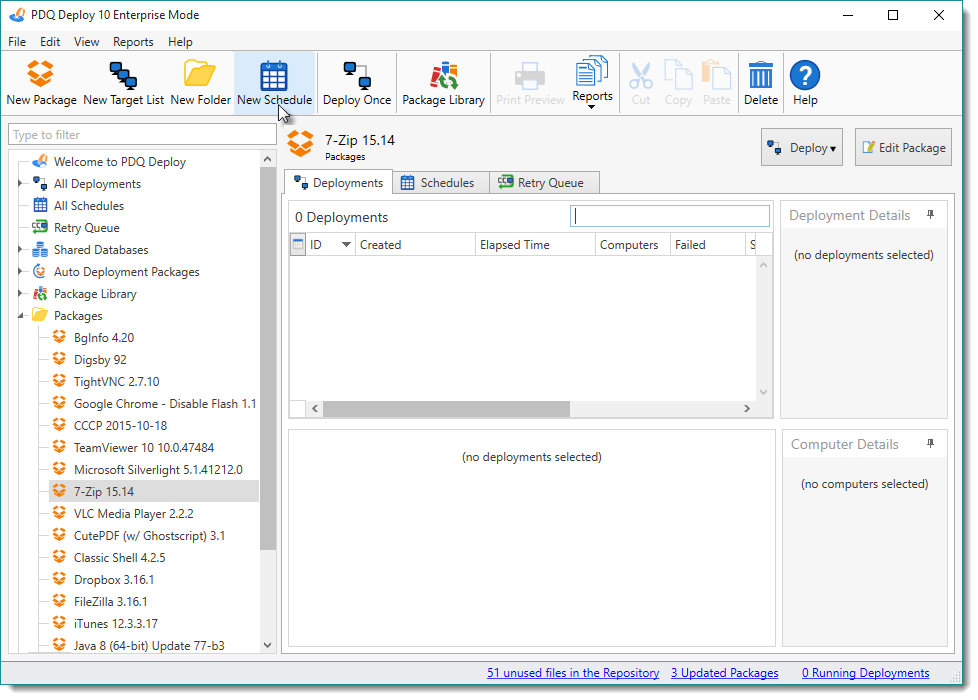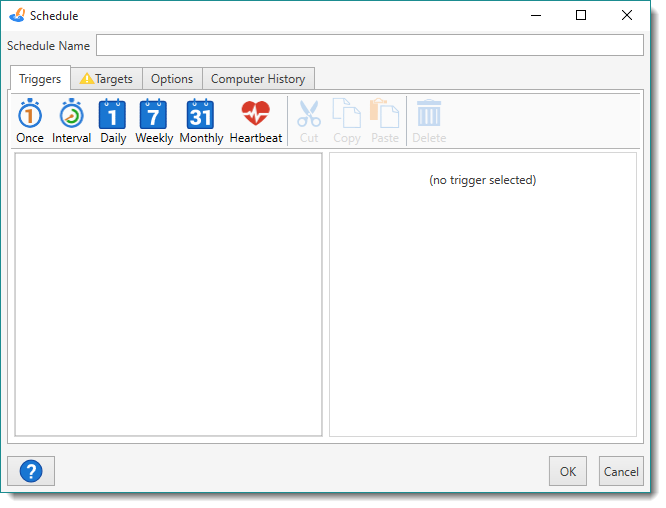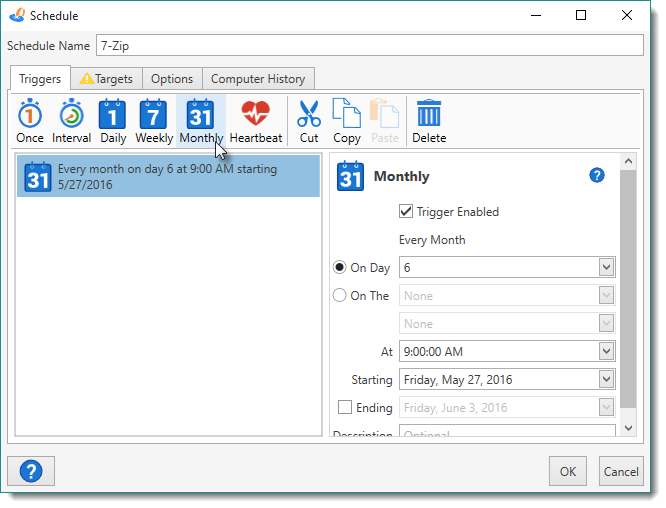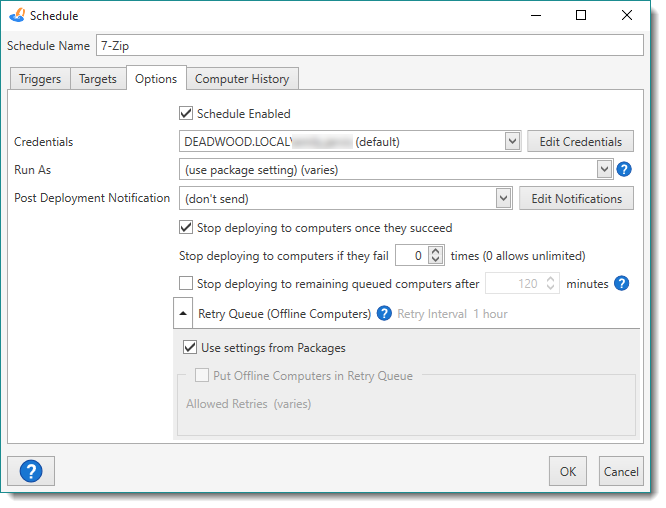Enterprise or Pro mode are required to create scheduled deployments. PDQ deployment schedules are created in the Schedule window. A new Schedule window can be started from the Main Console window on a Package page.
This procedure includes the following parts:
•Part 1: Creating a New Schedule
•Part 2: Schedule Triggers and Settings
•Part 4: Schedule Deployment Settings
•Part 5: Completing the Schedule
Part 1: Creating a New Schedule
To schedule a deployment:
1.On the Main Console window, select the package or packages (Shift+click or Ctrl+click) you want to deploy.
You can also create a new schedule without any packages and then attach one or more packages later (see Editing Packages). You can also nest packages to include multiple packages (see Nested Package Step Properties).

NOTE: When creating a schedule, you can select a package from your local system or from the Package Library. When you create a schedule using a package in the Package Library, you are starting an auto deployment (Enterprise license mode required). For details about configuring auto deployments, see Creating Auto Deployments.
2.Do one of the following:
•On the Toolbar, click New Schedule ![]() .
.
•Click File > New Schedule.
•Right-click the package (or one of the selected packages) and select New Schedule.
•On the selected Package window, click Deploy > New Schedule.
•If multiple packages are selected, on the Multiple Packages page, select Create new schedule with these packages.
A new blank Schedule window opens on the Triggers tab.
IMPORTANT: The Packages tab does not appear in the Schedule window until after clicking OK to save and close. Once the Schedule window is reopened, the Packages tab will be visible and all selected packages will be listed.
3.Type a name for the Schedule.
Use a name that makes sense for the new schedule.

4.Continue to Part 2: Schedule Triggers and Settings.
Part 2: SCHEDULE TRIGGERS and Settings
To select a schedule trigger and configure schedule triggers:
1.On the Triggers tab, click a Schedule Trigger, then define the schedule settings.

A schedule can include one or more triggers. Be careful of creating conflicts when setting frequencies or using multiple triggers. If triggers overlap, only one deployment will start. For example, having two triggers, one for every Monday at noon and one for every day at noon, will not start two deployments every Monday. See the table below for additional scheduling tips.
The following table provides information on the schedule triggers and settings available on the Triggers tab.
Schedule Triggers |
Icon |
Details |
|
The type of schedule. Various settings are available on the schedule detail page to the right, depending on the schedule triggers. |
|
|
Deploys the package once in the future. •Trigger Enabled: Enables the schedule trigger for use (selected by default). •Trigger On: Select one time deployment date. •At: Time •Description: (Optional) Description of the schedule. |
|
|
Deploys (and repeats) at a set time interval. •Trigger Enabled: Enables the schedule trigger for use (selected by default). •Every: Select deployment interval by day, hour, and minute. •Starting: Select first deployment date. •At: Time •Ending: Date that the schedule ends. •At: Time •Description: (Optional) Description of the schedule. |
|
|
Deploys every day at the same time. •Trigger Enabled: Enables the schedule trigger for use (selected by default). •Every Day •At: Time •Starting: Date that the schedule starts. •Ending: (Optional) Date that the schedule ends. Select to enable the end date. •Description: (Optional) Description of the schedule. |
|
|
Deploys every week at the same time on selected days of the week. •Trigger Enabled: Enables the schedule trigger for use (selected by default). •Every Week •On: Day or Days that the package deploys. •At: Time •Starting: Date that the schedule starts. •Ending: (Optional) Date that the schedule ends. Select to enable the end date. •Description: (Optional) Description of the schedule. |
|
|
Deploys every month at the same time on selected days. •Trigger Enabled: Enables the schedule trigger for use (selected by default). •Every Month •On Day: The day (or multiple days) of the month (for example, 1st, 12th, 23rd, etc.) Or •On The: The nth (for example, 1st, 2nd, Last, etc.) day of the month (for example, All, Weekend Days, Sunday, Monday, etc.) TIP: Days of Month: If you select the 29th, 30th, or 31st of the month, the package won't deploy in months without those days. Use Last to always deploy on the last day of the month. Can be mixed with Weeks of the Month. TIP: Weeks of Month: Different combinations of weeks and days require separate schedules (for example, the 1st Monday and the 2nd Friday.) Selecting the 5th week won't deploy in a month without a fifth week. Use Last to always deploy on the last week of the month. Can be mixed with Days of the Month. •At: Time •Starting: Date that the schedule starts. •Ending: (Optional) Date that the schedule ends. Select to enable the end date. •Description: (Optional) Description of the schedule. |
|
|
Deploys to target computers when their status changes from Offline to Online in PDQ Inventory. (Requires PDQ Inventory in Pro or Enterprise mode.) For more information, see Deploying When Target Computers Come Online with Heartbeat Schedules. •Trigger Enabled: Enables the schedule trigger for use (selected by default). •Starting: Date that the schedule starts. •At: Time •Ending: (Optional) Date that the schedule ends. Select to enable the end date. •At: Time •Description: (Optional) Description of the schedule. |
2.Continue to Part 3: Schedule Targets.
Part 3: Schedule Targets
To add target computers to the schedule:
1.Click the Targets tab.
2.(Optional) To manually add a target computer to the list, type a computer name in the Targets field, then click Add Computer. Alternately, you can also paste a target computer name (or list of names) directly into the Target area of the window. If copying a list of names, ensure that there is only one target computer name per line.
When you add a target computer manually, the name appears in the list and the system (DNS) checks to be sure it exists on the network.
3.(Optional) To add specific target computers to the schedule by selecting computer names from external sources, click Choose Targets and select an option.
Select target computers using one of the following options:
Source |
Description |
Active Directory |
Select target computers from Active Directory containers or groups. |
PDQ Inventory |
Select target computers from PDQ Inventory Collections. |
Spiceworks |
Select target computers from Spiceworks Groups. |
Target List |
Select target computers using other PDQ Deploy Target Lists. |
Text File |
Select a text file containing a list of target computer names. |
For detailed information about Choose Target, see Creating a Target List, Part 2: Choose Targets.
4.(Optional) To add linked lists of target computers to your schedule, click Link To and select an option.
Link to lists of target computers using one of the following options:
Source |
Description |
Active Directory Container |
Select Active Directory containers or groups. |
PDQ Inventory Collection |
Select PDQ Inventory Collections. |
Spiceworks Group |
Select Spiceworks Groups. |
Target List |
Select other PDQ Deploy Target Lists. |
For detailed information about Link To, see Creating a Target List, Part 3: Link To (Linked Target List Elements).
5.Continue to Part 4: Schedule Deployment Settings.
Part 4: Schedule Deployment Settings
To define deployment settings for the schedule:
1.Click the Options tab.

The following table provides information on the Deployment settings available on the Schedule Options tab:
Option |
Details |
|
Schedule Enabled |
Enables the Schedule. IMPORTANT: If this option is not selected this Schedule will not run. |
|
The credentials used by all deployments in the current schedule. This is the username and password used to connect to the target computer and copy over the necessary files and start the target service. This user must have administrative rights on the target computer, which are needed to copy files to the ADMIN$ share and create and start the remote service. It can be a user account local to the target computer or a domain user if using Active Directory. |
||
Determines how all deployments from the current schedule are executed on target computers. IMPORTANT: This feature is available only in Pro or Enterprise Mode. For a sample demonstration of the Run As options, see the following video. VIDEO: Deployment Run As Options
(http://www.adminarsenal.com/videos#!deployment-run-as-options) |
||
|
Use Package Setting |
Uses the Run Package As setting defined at the Package level. If you select this option but the Run Package As setting is not defined at the Package level, then PDQ Deploy uses the global Run Package As setting defined in Preferences. |
Deploy User |
Silently executes deployments on target computers. This setting is appropriate for the vast majority of deployments. |
|
Deploy User (Interactive) |
Executes deployments that include both silent and interactive steps. This setting is the same as Deploy User with one important exception—the Windows process running the deployment is run in interactive mode. This setting is most appropriately used for individual deployments that require user input, but the overall process still requires Administrator rights that logged on users may not have. This type of deployment requires more processing resources. |
|
Local System |
Executes deployments using the Local System account on the target computer. PDQ Deploy connects to the target computer, copies the specified files, then runs the actual deployment service using the Local System credentials. This setting is used only for installations that require Local System. These types of deployments are very rare. |
|
Logged On User |
Attempts to run packages in Interactive mode as the Logged On User of the target machine. This setting is used to deploy applications that are installed per user or when the logged on user needs to provide information for the deployment to succeed such as a license key. It can also be used to modify the HKEY-CURRENT-USER registry hive for the logged on user or to access user-specific settings such as %APPDATA% or the logged on user’s User directory. |
|
Stop deploying to computers once they succeed |
Stops deploying to computers that have already succeeded. NOTE: Success parameters are defined at the Package level. |
|
Stop deploying to computers if they fail xx times |
Stops deploying to computers once they fail the designated number of times. Setting to zero (0) allows unlimited attempts. |
|
Stop deploying to remaining queued computers after xx minutes |
Stops deploying and aborts all remaining target computers after the designated number of minutes. Any computers that are running when the timeout elapses will complete their deployment. This option is useful for overnight deployments so queued computers can be stopped before anyone arrives in the office. |
|
Sends an email notification when the deployment finishes. (Pro or Enterprise mode required.) Select one of the two default post deployment notifications, Full Details or Summary, or create a custom notification by clicking Edit Notifications. For more information about post deployment emails, see Receiving a Status Email After Deployment and Mail Server Preferences. IMPORTANT: You must configure the Mail Server settings in Preferences as well as designate at least one email recipient in the selected Post Deployment Notification before you can enable this option. |
||
Retry Queue settings determine how deployments are handled when the target computers are offline. |
||
Use settings from Package |
Uses the Retry Queue settings defined at the Package level. For more information, see Creating a New Package, Step 1: Package Properties. If you select this option but Retry Queue settings are not defined at the Package level, then PDQ Deploy uses the global Offline settings defined in Preferences. When you select this option, the subsequent Retry Queue settings are disabled. |
|
Put Offline Computers in Retry Queue |
Enables the Retry Queue. By default, target computers that are unreachable or offline during a deployment are held in the Retry Queue and deployment is retried. |
|
Allowed Retries |
Sets the number of retry attempts for an offline computer. This applies per target per deployment. The default setting is 72. To set unlimited retries, set this value to 0. |
|
2.Continue to Part 5: Completing the Schedule.
Part 5: Completing the Schedule
To complete the new schedule:
1.(Optional) Click the Computer History tab to view the deployment history of the schedule.
This tab displays a list of computers, by attached package, that have received deployments using this schedule. Since this is a new schedule, there is no data to display. For more information, see Managing Schedules.
2.When you are finished configuring the schedule, click OK.
The package attached to the schedule deploys according to the settings in your new schedule. Note that if you created a schedule without a package, you need to add one or more packages before the schedule can deploy.
3.(Optional) To start the deployment immediately rather than wait for it to run when scheduled, under Schedule Details, click Start Schedule.
The scheduled package deploys immediately.
4.View the progress and the status of the deployment in Deployment Status.
During a deployment you can stop deploying to one or more of the pending target computers by right-clicking on the target(s) and clicking Abort. To retry deployments to computers that fail, right-click the target, and click Redeploy or press Ctrl+R. If a target computer fails, you can view details about the failure, and possible solutions, by clicking the More Info link or the Steps link.
For more information about what happens during and after a deployment, see Verifying Deployment Status.
© 2016 Admin Arsenal, Inc. All rights reserved.
Admin Arsenal is a trademark of Admin Arsenal, Inc. All other product and company names are the property of their respective owners.
Help Version: 10.2.0.0